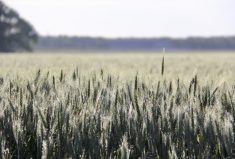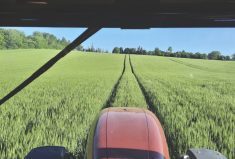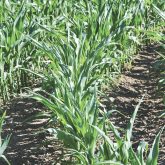There’s so much to like about cereals in Eastern Canada, whether you’re talking winter or spring wheat, oats, barley or even rye. They’re great for the soil, with stubble and roots that help improve soil organic matter levels and boost yields in subsequent corn and soybean crops (especially winter wheat), and there are benefits for soil fertility too. Plus, cereals provide a helpful break in many insect, weed and disease cycles.
Agronomics aside, though, there’s a problem. Why can’t they pay? Growers point at cereal yields and revenue, and then walk away.
Read Also

Producers aren’t panicking over tariffs and trade threats
The influence of tariff and trade uncertainity on farm business decisions.
They know that, when you consider how we plant cereals under such stressful field conditions, there’s a lot to like and even admire. But if only we could get some more bushels…
Heading East
Changes in attitude about cereals have always affected production in Eastern Canada. The cereal market has seen several acreage swings in the past eight years, often as a result of field conditions, economics or a preference for the simplicity of a corn-soybean rotation. Yet the numbers for Ontario cereal production show there is stability, even if the combined harvested acreage averages less than 1.2 million per year since 2012 (see Table 1 below).
Perhaps the acreage might grow with more research, but private sector investment in cereal breeding just doesn’t compare to corn, soybeans and canola (not surprising, since our research is dominated by companies based in the U.S. Midwest, where cereals aren’t a big deal).
On a national scale in Canada, much of the effort in public sector cereal breeding in past decades has focused on developing varieties that are suited to western production, which also makes sense given the larger acreage there. However that approach has shifted in the last five years with a more proactive focus on developing improved traits and varieties across all cereal crops, with eight public sector research positions in Ontario and Quebec. Seven of the posts are filled by researchers developing soft red winter wheat, hard red winter wheat, soft white spring wheat, hard red spring wheat, oat and barley cultivars, and improving disease resistance. The eighth, tied to University of Guelph, is to be filled in the coming months.
“It’s some of the strongest capacity we’ve had in place in these roles for quite some time, when it comes to wheat breeding specifically,” says Dr. Josh Cowan, manager of research and innovation with the Grain Farmers of Ontario. “To be able to provide producers with a really good third option that helps with soil health and mitigating risks on an operation, having competitive cereal crops is important.”
Cowan notes there’s good collaboration across the sector, but it has been a challenge to assemble all the resources needed in the province to get varieties into the hands of producers, even if those varieties could raise the cereal production bar.

There’s another consideration too. Ontario has a diverse cereal sector, with four classes of wheat alone.
“Wheat’s not just wheat, and being able to make sure we have some degree of capacity to retain those markets, not just in soft red winter wheat but also hard red spring, soft white winter and hard red winter wheat is important,” Cowan notes. “To keep those markets viable and to be able to supply them we need to continue to invest in those areas.”
Distinct diversity
The other factor that makes this an important success story for eastern Canadian breeding and development is the geography and impact of climate on crops in this half of the country. Ontario alone has microclimates in each of its primary growing areas (southern, central and eastern Ontario, the Near North and a small but vibrant tract in northwestern Ontario). In Quebec, there are farming concentrations north of Rouyn-Noranda, western Quebec, the Eastern Townships and along the St. Lawrence. And then there are the Atlantic provinces. All have very particular weather patterns plus soil and growing conditions that can challenge a grower.
“It doesn’t matter how small the acreage is in one region, if you’re going to maintain viable, competitive agriculture, you have to have programs focused on those regions,” says Jeff Reid, general manager with SeCan. “Where that may not make sense for a private company to invest in that research and development based on that acreage, from a producer perspective, we know the returns on investment in plant breeding are as high as 20 to one. That’s where we really need to leverage public sector dollars, producer dollars and industry to make that come together.”
Reid is thankful to have the collaborative efforts of Agriculture and Agri-Food Canada (AAFC), the University of Guelph, the Grain Farmers of Ontario, CÉROM (Le Centre de recherche sur les grains) and other smaller participants, to help build the research capacity for Eastern Canada. He’s especially encouraged by the “youth movement” that’s taken shape with several positions at AAFC-Ottawa and CÉROM in Quebec.
“It’s really taken a lot of leadership in terms of joint efforts with producers,” says Reid. “Nowadays, it’s hard to mobilize public dollars unless you can demonstrate that you have people in the industry or on the producer side who will leverage the dollars. The exciting thing about all of these is that none of these breeding programs are starting with a blank slate: they’re all coming in with a solid base and we’ve been able to ramp that up with private-sector partnerships.”
Reid praises the effort to keep a full pipeline of cutting-edge, public-sector genetics and building on those by making crosses in Ontario.
Quantity still rules
It’s also a challenge to ensure the latest cereal varieties maintain that balance between yield and the quality parameters demanded by millers, plus other traits affecting production, like protein or standability. The milling market is significant and with wheat, there are formal quality requirements to get varieties into certain classes. The challenge to breeders then is make sure they’re moving in the right direction, maintaining the productivity of the crop.

“Hard red wheats require a higher level of protein and the wheat class system already addresses that,” says Cowan,
“The more you add in extra quality parameters, the more difficult it is to ensure it performs well in the field at the same time — and stays competitive. If end-use markets open up that are willing to pay for some new characteristics, then that becomes a market opportunity we could look at.”
Since two of the public sector researchers are also dedicated to oats and barley, opportunities in those crops could be in the works, as well. Interest in winter barley is on the rise, with SeCan co-ordinating four registration trial sites across southwestern Ontario this past fall, a first for winter barley in Canada for many years. In all, there are five varieties for consideration, with entries from private programs as well.
The winter barley cultivars bring higher yield potential but because the crop is planted earlier than winter wheat, soybean harvest has to be early. But then winter barley comes off earlier than winter wheat by roughly two weeks, making it a better candidate for double cropping.
In spring barley, there’s also interest in malt varieties, with markets in Quebec and possibly Ontario. In fact, barley is emblematic of the new age of cereal breeding. It’s about the economics. Proof? These new spring malt barleys that SeCan has been evaluating are out-yielding their highest-yielding feed varieties.

















